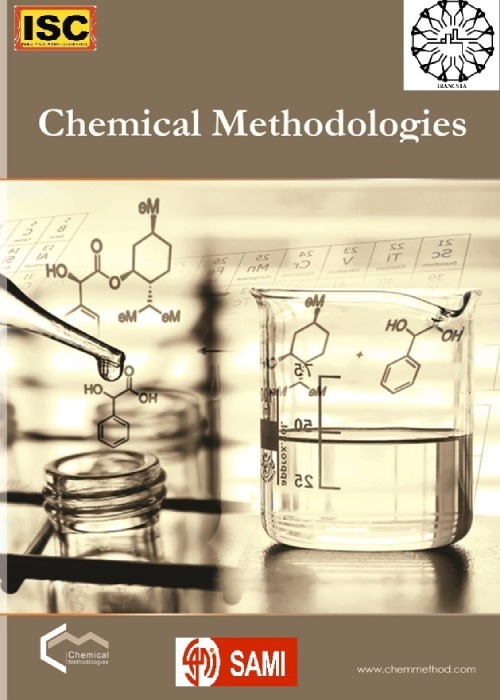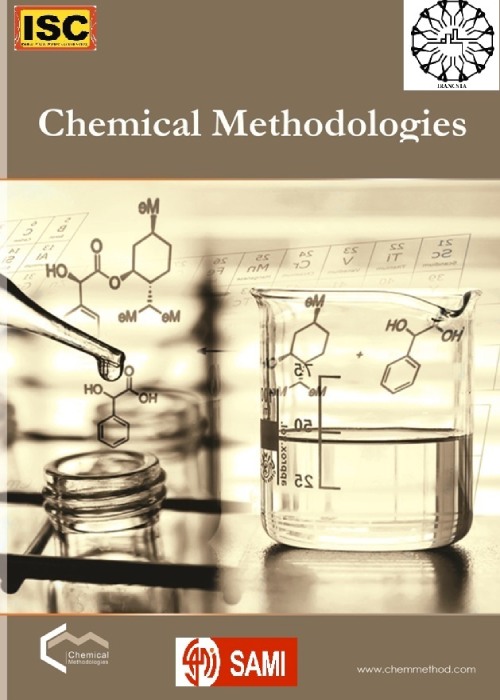فهرست مطالب

Chemical Methodologies
Volume:8 Issue: 3, Mar 2024
- تاریخ انتشار: 1402/12/11
- تعداد عناوین: 5
-
-
Pages 154-163The primary objective of this study was to devise a straightforward and environmentally sustainable approach for creating Biginelli compounds. Accordingly, a p(AMPS) hydrogel served as an effective catalyst of diverse nature, facilitating the preparation of 3,4-dihydropyrimidine-2-(1H)-ones, commonly recognized as Biginelli compounds. The chemical process unfolded using an eco-friendly method, resulting in notably abundant product yields. Moreover, the catalyst exhibited remarkable reusability, maintaining its efficacy through four cycles without a substantial decline. The innovative Biginelli reaction technique achieves environmentally conscious synthesis, robust product generation, simplified isolation procedures, catalyst sustainability, and avoids harmful by-products.Keywords: Hydrogel, Biginelli reaction, Multi-component reactions
-
Pages 164-176This study was conducted to evaluate the photocatalytic applications and the cytotoxicity effects of Ag-Se doped ZnO-Co3O4-NiO fivenary nanocomposite synthesized using polyanionic cellulose (PAC) polymer as a stabilizer agent. Several procedures such as XRD, FESEM, FTIR, EDX, PSA, and UV-Vis were applied to investigate synthesized nanocomposite. Consistent with the FTIR spectrum, chemical bonds were seen in the structure of the nanocomposite which approved the successful synthesis of them. The XRD pattern of the synthesized nanocomposite revealed sharp diffraction peaks with high crystallinity, and pure phases of Se, Ag, ZnO, NiO, and Co3O4 were approved with XRD analysis. FESEM/PSA images indicate that nanocomposite was synthesized with an average size of 23-49 nm and relatively uniformly distributed, in addition, it has a spherical morphology. The synthesized nanocomposite exhibited excellent photocatalytic activity to methyl orange (MO) dye degradation under a UVA light source. The degradation rate of nanocomposite reached 99% within 80 min. The kinetic studies indicate that the degradation of MO dye follows a first-order kinetic model. The cytotoxicity of the nanomaterial was assessed on normal mouse fibroblast NIH3T3 and cancer mouse melanoma B16F0 cell lines with the MTT assay. The results of the MTT test revealed significant cytotoxic influences on cancer B16F0 cells (IC50 value = 258.5 µg/mL) in comparison to normal cells.Keywords: Ag-Se doped ZnO-Co3O4-NiO fivenary Nanocomposite, Poly Anionic Cellulose, Photocatalytic, Anticancer
-
Pages 177-199The surface of bio-synthesized TiO2 nanoparticles was modified with a silane agent to generate the chemical link to the preparation of TiO2/β-cyclodextrin and TiO2/Ag/β-cyclodextrin nanocomposites. The structure of synthesized nanocomposites was identified using different techniques, including FTIR, DRS, XRD, ICP, TGA, FESEM, and EDX MAPPING. The photocatalytic activity of the nanocomposites was investigated in the degradation of methylene blue dye in aqueous solution under sunlight irradiation (400-700 nm). The effective factors in the degradation of methylene blue dye including, nanocomposite dosage, initial methylene blue concentration, and irradiation time were studied. The results revealed that under optimum degradation conditions (0.01 g nanocomposite, initial methylene blue concentration of 10 ppm, and 120 min sunlight exposure time), TiO2/Ag/β-cyclodextrin exhibited the highest photocatalytic activity among the tested nanocomposites. The photocatalytic efficiency of nanocomposites showed the order: TiO2/Ag/β-cyclodextrin (99.38%)> TiO2/β-cyclodextrin (84.1%)> TiO2 nanoparticles (63.76 %). Photocatalytic activity of the synthesized nanocomposites revealed that these materials could be promising candidates for the degradation of various pollutants.Keywords: β -cyclodextrin, TiO2 nanocomposites, photocatalyst, Methylene blue, Visible light
-
Pages 200-216In recent years, biomedicine has focused extensively on developing a biologically versatile drug delivery system characterized by responsive behavior and customizable properties. Among drug carriers, hydrogels can be a suitable option. Since they have specific surface and structure to selectively maintain and transport the drug to the operation area, they are released in a favorable time frame to provide a higher therapeutic effect. Here, we announce the synthesis of co-polymer of poly (sodium alginate (Alg) and 2-hydroxyethyl methacrylate (HEMA)) in high internal phase emulsions (HIPEs), to produce highly porous hydrogel which has been developed to load chemotherapeutic drug doxorubicin (DOX). The percent of porosity can be changed with the variables involved in the polymer synthesis procedure. The developed beads were characterized by Fourier transform infrared spectroscopy (FTIR), thermogravimetric analysis (TGA), and scanning electron microscopy (SEM). In vitro release studies were investigated in pH 5.4 and 7.4 at 37 and 42 °C, it was shown that DOX was effectively incorporated into the porous hydrogel and released in a controlled manner through pH regulation and the swelling-shrinking process. The presence of hydroxyl and carboxylic acid groups in the structure of synthesized poly HIPE enhances the pH-sensitivity and swelling behavior of the resulted hydrogel, which can be designed to release drugs selectively in response to the acidic conditions of the tumour, offering a promising strategy for localized and effective cancer therapy.Keywords: polyHIPE, Hydrogel, 2-hydroxyethyl methacrylate, Sodium Alginate, doxorubicin
-
Pages 217-233Pectin was extracted from bitter orange peels by subjecting them to electromagnetic field treatment and utilizing citric acid as an acidic catalyst. Fourier-Transform Infrared Spectroscopy (FTIR) analysis verified the presence of distinct functional groups in the pectin samples extracted using acidic catalysts, which exhibited spectra similar to commercially available pectin mentioned in previous studies. Scanning electron micrographs demonstrated that subjecting bitter orange peel to microwave heating led to the destruction of parenchymal cells. Furthermore, pectin samples were examined using scanning electron microscopy (SEM), revealing their structural changes. The extraction procedure was optimized using a multi-objective strategy based on yield-response surface techniques and the esterification degree. The experimental design employed a central composite design with five levels. The key variables under consideration were microwave power (ranging from 150 to 450 W) and solvent pH (ranging from 1.5 to 3.00). Optimal conditions were determined at a microwave power of 450 W and a solvent pH of 1.5, resulting in the highest yield (36.02%) and esterification degree (45.4) of pectin. The applied extraction model and its correlation were significant, as shown by the validation of the optimization model, which exhibited less than a 10% discrepancy between experimental and anticipated outcomes. To improve extraction efficiency, it is recommended to microwave fresh pectin raw materials before drying.Keywords: Pectin, Electromagnetic field treatment, Multi-Objective RSM Optimization, Bitter orange peels, Yield, Esterification Degree


